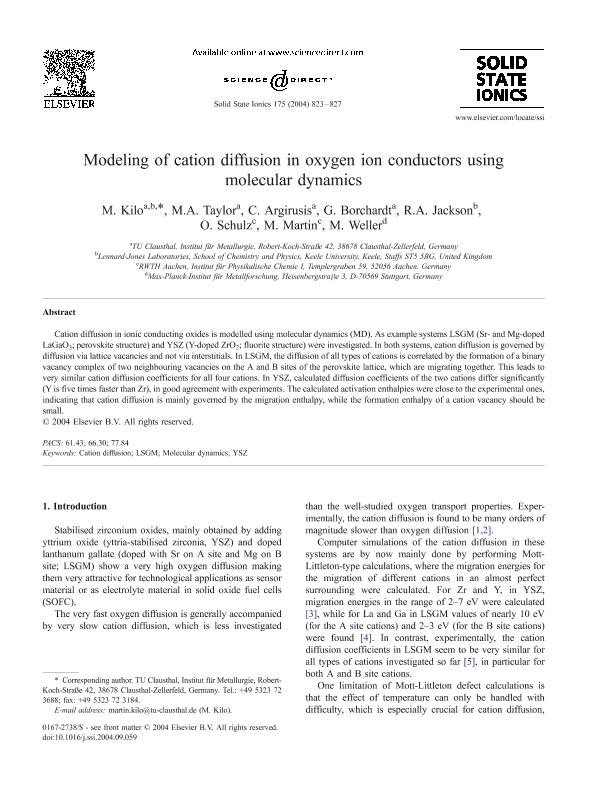Mostrar el registro sencillo del ítem
dc.contributor.author
Kilo, M.
dc.contributor.author
Taylor, Marcela Andrea

dc.contributor.author
Argirusis, C.
dc.contributor.author
Borchardt, G.
dc.contributor.author
Jackson, R.A.
dc.contributor.author
Schulz, O.
dc.contributor.author
Martin, M.
dc.contributor.author
Weller, M.
dc.date.available
2019-03-25T20:07:10Z
dc.date.issued
2004-11
dc.identifier.citation
Kilo, M.; Taylor, Marcela Andrea; Argirusis, C.; Borchardt, G.; Jackson, R.A.; et al.; Modeling of cation diffusion in oxygen ion conductors using molecular dynamics; Elsevier Science; Solid State Ionics; 175; 1-4; 11-2004; 823-827
dc.identifier.issn
0167-2738
dc.identifier.uri
http://hdl.handle.net/11336/72465
dc.description.abstract
Cation diffusion in ionic conducting oxides is modelled using molecular dynamics (MD). As example systems LSGM (Sr- and Mg-doped LaGaO3; perovskite structure) and YSZ (Y-doped ZrO2; fluorite structure) were investigated. In both systems, cation diffusion is governed by diffusion via lattice vacancies and not via interstitials. In LSGM, the diffusion of all types of cations is correlated by the formation of a binary vacancy complex of two neighbouring vacancies on the A and B sites of the perovskite lattice, which are migrating together. This leads to very similar cation diffusion coefficients for all four cations. In YSZ, calculated diffusion coefficients of the two cations differ significantly (Y is five times faster than Zr), in good agreement with experiments. The calculated activation enthalpies were close to the experimental ones, indicating that cation diffusion is mainly governed by the migration enthalpy, while the formation enthalpy of a cation vacancy should be small. © 2004 Elsevier B.V. All rights reserved.
dc.format
application/pdf
dc.language.iso
eng
dc.publisher
Elsevier Science

dc.rights
info:eu-repo/semantics/openAccess
dc.rights.uri
https://creativecommons.org/licenses/by-nc-sa/2.5/ar/
dc.subject
Cation Diffusion
dc.subject
Lsgm
dc.subject
Molecular Dynamics
dc.subject
Ysz
dc.subject.classification
Astronomía

dc.subject.classification
Ciencias Físicas

dc.subject.classification
CIENCIAS NATURALES Y EXACTAS

dc.title
Modeling of cation diffusion in oxygen ion conductors using molecular dynamics
dc.type
info:eu-repo/semantics/article
dc.type
info:ar-repo/semantics/artículo
dc.type
info:eu-repo/semantics/publishedVersion
dc.date.updated
2019-03-18T14:28:46Z
dc.journal.volume
175
dc.journal.number
1-4
dc.journal.pagination
823-827
dc.journal.pais
Países Bajos

dc.journal.ciudad
Amsterdam
dc.description.fil
Fil: Kilo, M.. Institut für Metallurgie; Alemania
dc.description.fil
Fil: Taylor, Marcela Andrea. Consejo Nacional de Investigaciones Científicas y Técnicas; Argentina. Institut für Metallurgie; Alemania
dc.description.fil
Fil: Argirusis, C.. Institut für Metallurgie; Alemania
dc.description.fil
Fil: Borchardt, G.. Institut für Metallurgie; Alemania
dc.description.fil
Fil: Jackson, R.A.. Keele University; Alemania
dc.description.fil
Fil: Schulz, O.. Institut für Physikalische Chemie I; Alemania
dc.description.fil
Fil: Martin, M.. Institut für Physikalische Chemie I; Alemania
dc.description.fil
Fil: Weller, M.. Max-Planck-Institut für Metallforschung; Alemania
dc.journal.title
Solid State Ionics
dc.relation.alternativeid
info:eu-repo/semantics/altIdentifier/doi/https://doi.org/10.1016/j.ssi.2004.09.059
dc.relation.alternativeid
info:eu-repo/semantics/altIdentifier/url/https://www.sciencedirect.com/science/article/pii/S0167273804006575
Archivos asociados
